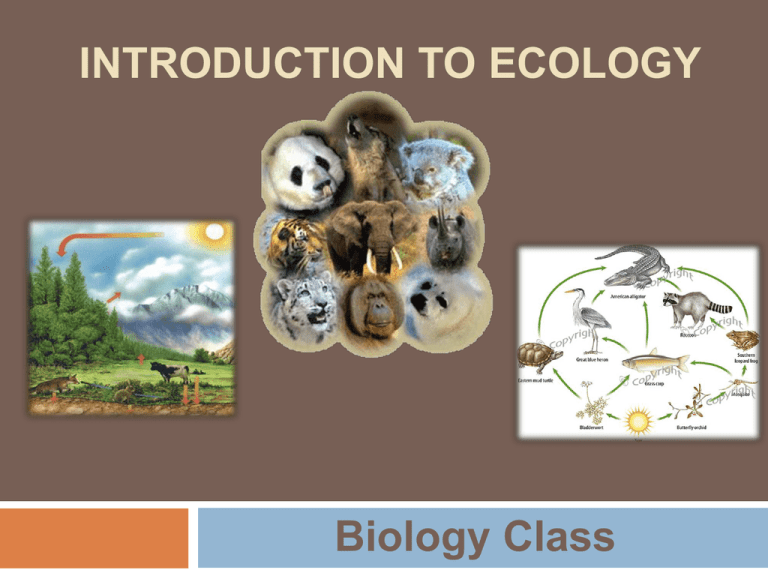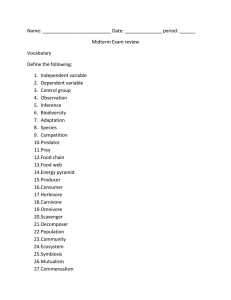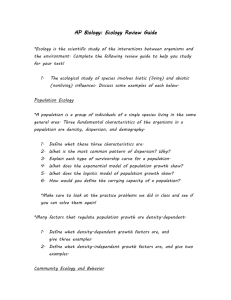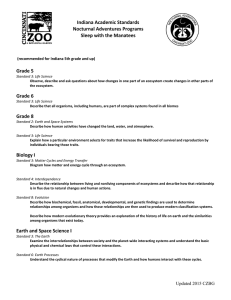INTRODUCTION TO ECOLOGY Biology Class
advertisement

INTRODUCTION TO ECOLOGY Biology Class What is Ecology? The study of how organisms interact with their environment All organisms must interact with both living and nonliving things that surround them. Levels of Organization To add to our list of the levels of organization: Tissues Organs Organ Systems Organisms Population Community Ecosystem Biosphere Cells The environment Made up of all the living and nonliving things that surround an organism. Vocabulary: Abiotic Factors Biotic Factors Environment vs Habitat Many species can survive in more than one environment. But each species has its “home” or habitat. Fish may be able to live in fish tanks, but would rather live in the wild Basic Concept of Ecology The fundamental idea behind the study of ecology is that all organisms are interdependent. They interact with one another and the physical environment. What do organisms need to survive? Basic requirements for survival include: Food Water Shelter Competition An important aspect of the struggle for survival involves competition for limited resources Food Water Shelter Sunlight Limiting Factors Limiting factors are factors that affect the population size of a species in a specific environment. They can be abiotic or biotic. Predator – Prey relationship Predators are a biotic limiting factor. They control population size by feeding on prey. There is a delicate balance that needs to be maintained. Carrying Capacity When all the limiting factors are considered together we can determine the maximum number of organisms that can survive in an area. How do we determine the Carrying Capacity of a Species? All limiting factors must be taken into consideration. It is very difficult to determine the actual carrying capacity. The Lesson of the Kaibab Deer Purpose: to graph data on the Kaibab deer population of Arizona from 1905~1939 to analyze the methods responsible for the changes in the deer population to propose a management plan for the Kaibab deer population Kaibab Forest: North Rim of the Grand Canyon Key Idea All organisms have the ability to produce populations of unlimited size But their environment keeps their numbers in check. Review of Types of Nutrition Autotrophic Heterotrophic Which is heterotrophic and which Autotrophic? Categories of Populations Populations are labeled by the function they serve in the ecosystem Producers Consumers Decomposers So what is a Food Chain? A food chain shows a one way flow of energy in an ecosystem It may not be the only way energy flows in the ecosystem Food Webs When all of the food chains of an ecosystem are considered we can draw up a food web It shows all of the possible paths that energy can take in an ecosystem It also shows how organisms are dependant on each other in the ecosystem Recycling Who is ultimately responsible for the recycling of nutrients? Decomposers What gets recycled? Minerals Nutrients Recycling What else gets recycled? Carbon Dioxide Water Carbon The energy from the Sun keeps the cycle going Carbon Cycle Water Cycle Nitrogen Cycle Energy Pyramid Energy Pyramid There is more energy available at the bottom There are more organisms at the bottom There is less energy at the top There are less organisms at the top Energy is lost as you go up the pyramid, mostly as heat Energy Pyramid Symbiosis Is a close ecological relationship between the individuals of two (or more) different species. Sometimes a symbiotic relationship benefits both species Sometimes one species benefits at the other's expense, Sometimes neither species benefits. Types of Symbiosis Mutualism: both species benefit. Commensalism: one species benefits, the other is unaffected. Parasitism: one species benefits, the other is harmed. Competition: neither species benefits. Neutralism: both species are unaffected. http://www.marietta.edu/~biol/biomes/symbiosis.htm The following table illustrates the correct use of these terms in interactions between Species "A" and Species "B". "+" denotes benefit to the species "0" denotes no positive or negative effect "-" denotes an undesirable effect of the interaction.









